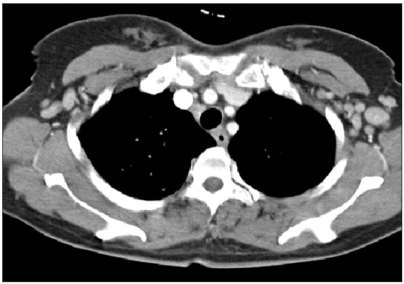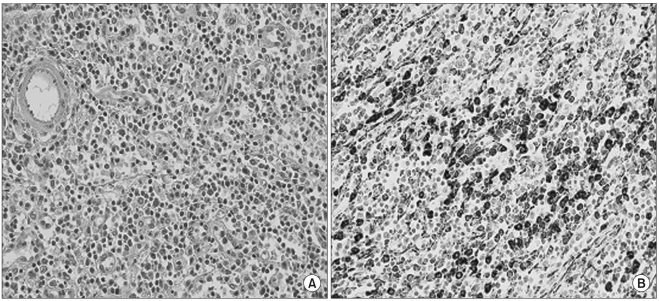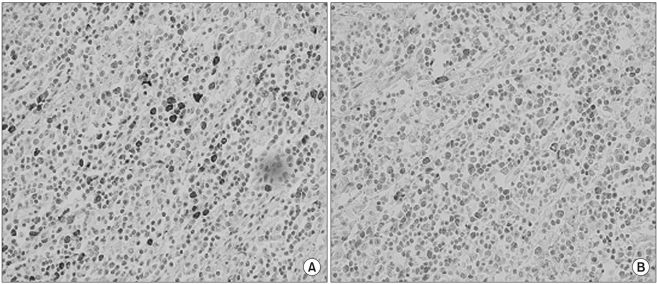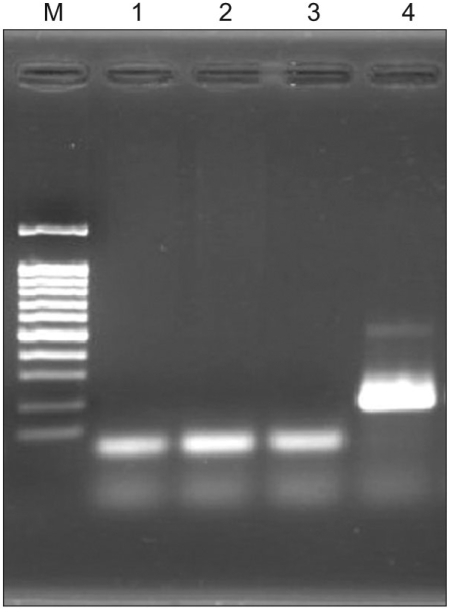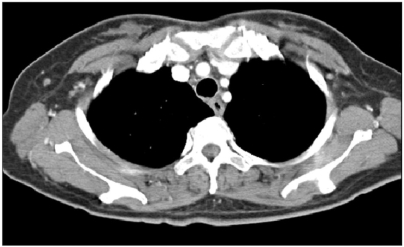Cancer Res Treat.
2009 Jun;41(2):104-107.
Complete Remission in a Patient with Human Herpes Virus-8 Negative Multicentric Castleman Disease Using CHOP Chemotherapy
- Affiliations
-
- 1Division of Oncology and Hematology, Department of Internal Medicine, Korea University College of Medicine, Seoul, Korea.
- 2Department of Pathology, Korea University College of Medicine, Seoul, Korea.
- 3Division of Hematology/Oncology, Department of Internal Medicine, Samsung Medical Center, Sungkyunkwan University School of Medicine, Seoul, Korea. kstwoh@skku.edu
Abstract
- Multicentric Castleman disease (MCD) is a rare lymphoproliferative disorder. Although MCD pathogenesis is unclear, studies have suggested that human herpesvirus 8 (HHV-8) may be associated with the disorder. Recent reports have identified MCD cases without viral infection. A 43-year-old woman presented to our hospital for fever and myalgia of 6 months' duration. The complete blood count revealed an elevated leukocyte count (15.1x10(3)/microliter) and a decreased hemoglobin level of 10.0 g/dL. The C-reactive protein level was elevated at 276.5 mg/L. Thoracic computed tomography (CT) scans revealed bilateral axillary lymphadenopathy. There was no evidence of HHV-8, human immunodeficiency virus (HIV), or Mycobacterium infection. Histologic evaluation of a lymph node biopsy from the left axilla yielded a diagnosis of MCD. Cyclophosphamide, adriamycin, vincristine, and prednisone (CHOP) were administered for a total of 4 cycles. The patient's fever and lymphadenopathy resolved after the course of chemotherapy. She has been in complete remission for 24 months at this writing. As previously reported, this case report suggests that MCD can develop without viral infection. CHOP chemotherapy may be an effective treatment option for newly diagnosed MCD patients.
MeSH Terms
-
Adult
Axilla
Biopsy
Blood Cell Count
C-Reactive Protein
Corneal Dystrophies, Hereditary
Cyclophosphamide
Doxorubicin
Female
Fever
Giant Lymph Node Hyperplasia
Hemoglobins
Herpesvirus 8, Human
HIV
Humans
Leukocyte Count
Lymph Nodes
Lymphatic Diseases
Lymphoproliferative Disorders
Mycobacterium Infections
Prednisone
Vincristine
Writing
C-Reactive Protein
Corneal Dystrophies, Hereditary
Cyclophosphamide
Doxorubicin
Hemoglobins
Prednisone
Vincristine
Figure
Reference
-
1. Castleman B, Iverson L, Menendez VP. Localized mediastinal lymphnode hyperplasia re sembling thymoma. Cancer. 1956; 9:822–830. PMID: 13356266.2. Ruco LP, Gearing AJ, Pigott R, Pomponi D, Burgio VL, Cafolla A, et al. Expression of ICAM-1, VCAM-1 and ELAM-1 in angiofollicular lymph node hyperplasia (Castleman's disease): evidence for dysplasia of follicular dendritic reticulum cells. Histopathology. 1991; 19:523–528. PMID: 1723957.
Article3. Keller AR, Hochholzer L, Castleman B. Hyaline-vascular and plasma-cell types of giant lymph node hyperplasia of the mediastinum and other locations. Cancer. 1972; 29:670–683. PMID: 4551306.
Article4. Gholam D, Vantelon JM, Al-Jijakli A, Bourhis JH. A case of multicentric Castleman's disease associated with advanced systemic amyloidosis treated with chemotherapy and anti-CD20 monoclonal antibody. Ann Hematol. 2003; 82:766–768. PMID: 12898190.
Article5. Ide M, Kawachi Y, Izumi Y, Kasagi K, Ogino T. Long-term remission in HIV-negative patients with multicentric Castleman's disease using rituximab. Eur J Haematol. 2006; 76:119–123. PMID: 16405432.
Article6. Frizzera G, Banks PM, Massarelli G, Rosai J. A systemic lymphoproliferative disorder with morphologic features of Castleman's disease. Pathological findings in 15 patients. Am J Surg Pathol. 1983; 7:211–231. PMID: 6837832.7. Chang Y, Cesarman E, Pessin MS, Lee F, Culpepper J, Knowles DM, et al. Identification of herpesvirus-like DNA sequences in AIDS-associated Kaposi's sarcoma. Science. 1994; 266:1865–1869. PMID: 7997879.8. Soulier J, Grollet L, Oksenhendler E, Cacoub P, Cazals-Hatem D, Babinet P, et al. Kaposi's sarcoma-associated herpesvirus-like DNA sequences in multicentric Castleman's disease. Blood. 1995; 86:1276–1280. PMID: 7632932.9. Aoki Y, Jaffe ES, Chang Y, Jones K, Teruya-Feldstein J, Moore PS, et al. Angiogenesis and hematopoiesis induced by Kaposi's sarcoma-associated herpesvirus-encoded interleukin-6. Blood. 1999; 93:4034–4043. PMID: 10361100.
Article10. Nishi J, Maruyama I. Increased expression of vascular endothelial growth factor (VEGF) in Castleman's disease: proposed pathomechanism of vascular proliferation in the affected lymph node. Leuk Lymphoma. 2000; 38:387–394. PMID: 10830746.
Article11. Berezne A, Agbalika F, Oksenhendler E. Failure of cidofovir in HIV-associated multicentric Castleman disease. Blood. 2004; 103:4368–4369. PMID: 15155471.
Article12. Marcelin AG, Aaron L, Mateus C, Gyan E, Gorin I, Viard JP, et al. Rituximab therapy for HIV-associated Castleman disease. Blood. 2003; 102:2786–2788. PMID: 12842986.
Article13. Rieu P, Droz D, Gessain A, Grunfeld JP, Hermine O. Retinoic acid for treatment of multicentric Castleman's disease. Lancet. 1999; 354:1262–1263. PMID: 10520638.
Article
- Full Text Links
- Actions
-
Cited
- CITED
-
- Close
- Share
- Similar articles
-
- Human Herpesvirus-8 Positive Multicentric Castleman’s Disease with Complete Response after Rituximab Monotherapy: A Case Report
- Human Herpes Virus 8/Epstein-Barr Virus–Copositive, Plasmablastic Microlymphoma Arising in Multicentric Castleman's Disease of an Immunocompetent Patient
- A Case of Kaposi's Sarcoma Associated with Castleman's Disease
- Kaposi Sarcoma Herpes Virus-associated Hemophagocytic Syndrome Complicated by Multicentric Castleman Disease and Kaposi Sarcoma in a HIV-negative Immunocompetent Patient: An Autopsy Case
- General anesthesia in a patient with multicentric Castleman's disease: a case report

